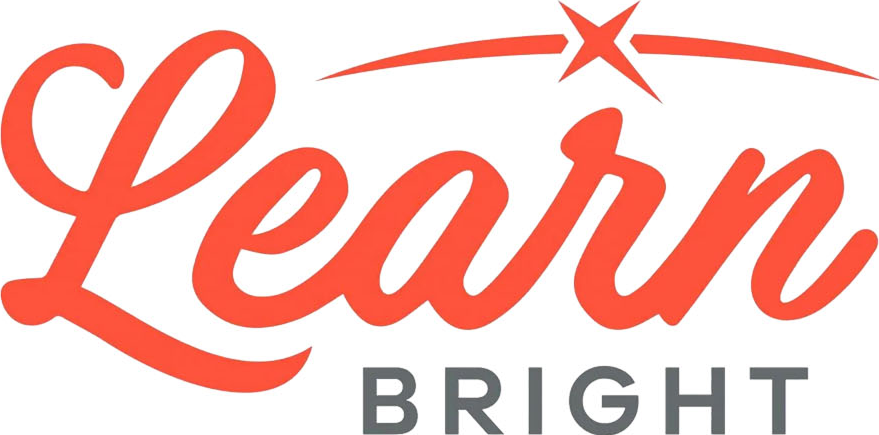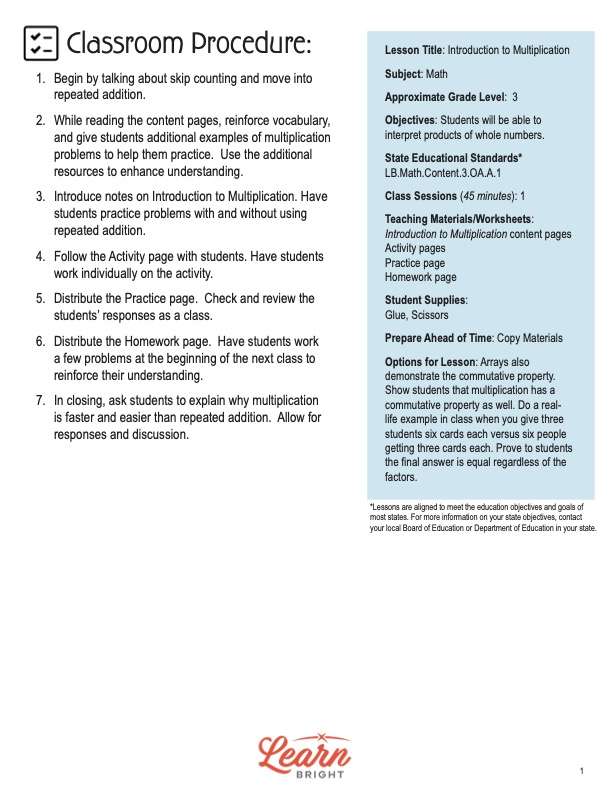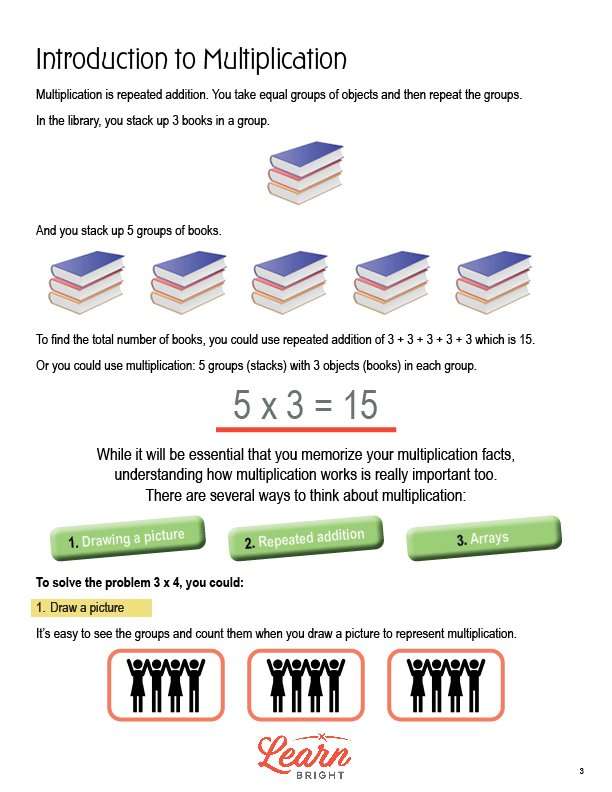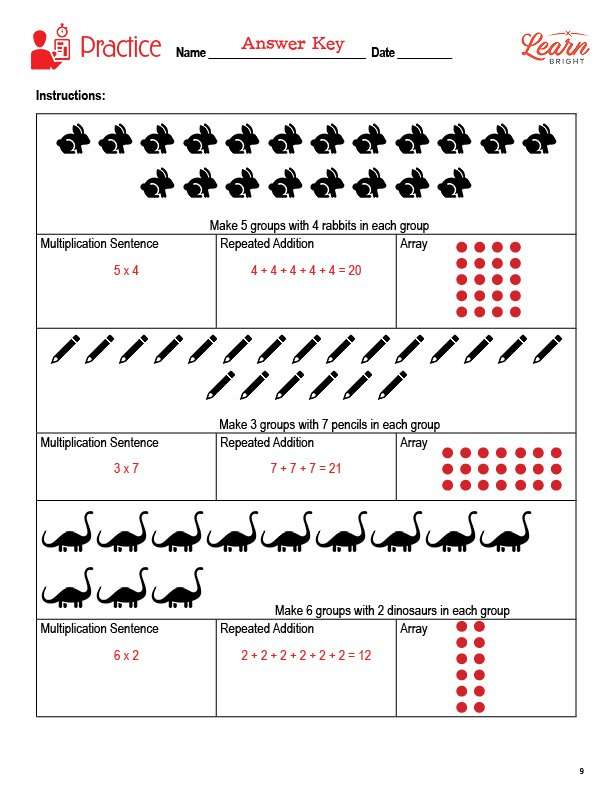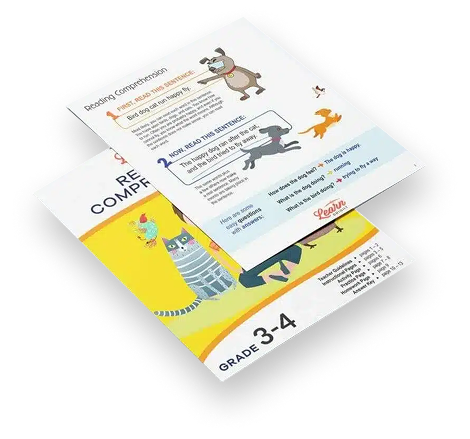Description
What our Introduction to Multiplication lesson plan includes
Lesson Objectives and Overview: Introduction to Multiplication teaches students to the foundational basics of multiplying using drawings, repeated addition, and arrays. Students will be able to interpret products of whole numbers. They will walk through several example problems. By then end of the lesson, they will be able to solve and create their own problems. This lesson is for students in 3rd grade.
Classroom Procedure
Every lesson plan provides you with a classroom procedure page that outlines a step-by-step guide to follow. You do not have to follow the guide exactly. The guide helps you organize the lesson and details when to hand out worksheets. It also lists information in the blue box that you might find useful. You will find the lesson objectives, state standards, and number of class sessions the lesson should take to complete in this area. In addition, it describes the supplies you will need as well as what and how you need to prepare beforehand. The only supplies you will need for this lesson are glue scissors, and the handouts. To prepare for this lesson ahead of time, you can gather the supplies and copy the handouts.
Options for Lesson
Included with this lesson is an “Options for Lesson” section that lists a number of suggestions for activities to add to the lesson or substitutions for the ones already in the lesson. It notes that arrays also demonstrate the commutative property.
Teacher Notes
The teacher notes page includes a paragraph with additional guidelines and things to think about as you begin to plan your lesson. It notes that the lesson uses multiple methods to teach students multiplication of whole numbers. This page also includes lines that you can use to add your own notes as you’re preparing for this lesson.
INTRODUCTION TO MULTIPLICATION LESSON PLAN CONTENT PAGES
Introduction to Multiplication
The lesson contains three pages of content to guide students through the process of multiplying whole numbers. The lesson begins by explaining that multiplication is repeated addition. It provides an example with pictures that will help students understand how this concept works. The example explains that, to find 5 x 3, you can use repeated addition (3 + 3 + 3 + 3 + 3 = 15), but using multiplication is faster (5 x 3 = 15). The lesson also states that knowing how multiplication works is at least as important as memorizing multiplication facts.
There are three ways to think about multiplication and solve multiplication problems. The first is drawing a picture, the second is repeated addition, and the third is arrays. The lesson uses the example of the problem 3 x 4 to illustrate each of these three ways. To solve 3 x 4 using pictures, you could draw three groups of four people, and could then skip count (4, 8, 12) to find the answer. Drawing a picture makes it easy to see the groups and count them. To solve 3 x 4 using repeated addition, you would simply have to add 4 + 4 + 4 to get 12. Finally, to solve 3 x 4 using arrays, you could draw dots in an array that shows three rows with four dots in each row, for a total of 12 dots.
The lesson closes with two more examples: 4 x 6 and 2 x 7. It shows how you would solve these problems using the three methods listed above.
INTRODUCTION TO MULTIPLICATION LESSON PLAN WORKSHEETS
The Introduction to Multiplication lesson plan includes three worksheets: an activity worksheet, a practice worksheet, and a homework assignment. You can refer to the guide on the classroom procedure page to determine when to hand out each worksheet.
MAKE YOUR OWN PROBLEM ACTIVITY
For the activity, students will cut out 10 numbers from the worksheet. They will take the cut-out numbers and glue them to the squares in the equation boxes. There are five blank equations to which they can glue their numbers. Then they will have to solve their equations using a specific method. Each equation has a box next to it that shows which method the students must use.
PICTURES PROBLEMS PRACTICE WORKSHEET
The practice worksheet shows three sets of pictures. Each picture has an instruction below it describing what the student must do. There are three boxes beneath each picture set that show the three methods students will use to show their answers.
INTRODUCTION TO MULTIPLICATION HOMEWORK ASSIGNMENT
Students must solve four different problems using one method. Each problem shows three method options. They have to use each method at least one time, but they will use one method twice.
Worksheet Answer Keys
This lesson plan includes answer keys for the activity worksheet, the practice worksheet, and the homework assignment. If you choose to administer the lesson pages to your students via PDF, you will need to save a new file that omits these pages. Otherwise, you can simply print out the applicable pages and keep these as reference for yourself when grading assignments.
